Dr. Rader incorporates the advantages of cosmetic dentistry into the comprehensive general dental care. From check-ups, fluoride treatment and cleaning, to restoring cavities with tooth colored options and more. Dr Rader does majority of general dental procedures in order to keep your family’s smiles healthy and beautiful.


 “At my first visit to Dr. Rader’s office I was not only impressed with how personable he was, but also his staff. I have not always had the best smile as I have always been a grinder and have smoked for years. Dr. Rader and I discussed veneer’s, he went through the whole process with me from start to finish, and I decided to have them done. It was the best decision I made. I absolutely love my new smile.”
“At my first visit to Dr. Rader’s office I was not only impressed with how personable he was, but also his staff. I have not always had the best smile as I have always been a grinder and have smoked for years. Dr. Rader and I discussed veneer’s, he went through the whole process with me from start to finish, and I decided to have them done. It was the best decision I made. I absolutely love my new smile.”
If you are like most people, you probably have cavities that have been filled with metal of silver-mercury amalgam. While you probably recognize that such fillings are unattractive in your smile, you might not realize that they are hazardous to your teeth.
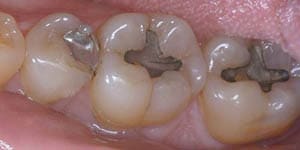
Silver-mercury fillings react to temperature changes, expanding and contracting within your delicate tooth. This environment can weaken the tooth, causing it to break. It can also create a space between the tooth surface and filling that allows bacteria to enter, causing decay.
Fortunately, there are metal-free fillings-composite resisns and porcelain restorations that are stronger and safer for your teeth. These restorations are virtually invisible,
For small cavities we use non-metal composite filling for restoration. Blending to the tooth color, composite fillings offer a lasting, attractive alternative to metal. Composite fillings are completed in the office in one visit.
For situations where more of the tooth has been destroyed by decay Inlay/Onlay is a very viable option.
 “The facial pain, bruxism and other symptoms I had lived with for the past few years disappeared. And I have a lovely, bright smile as a benefit. Dr. Rader and his team are very professional and provide caring, attentive service. They did a great job of informing me about the procedures, addressing my concerns regarding discomfort and explaining what I could expect. I totally recommend Dr. Rader and his team, particularly to those who are suffering from neuromuscular dental issues like TMJ.”
“The facial pain, bruxism and other symptoms I had lived with for the past few years disappeared. And I have a lovely, bright smile as a benefit. Dr. Rader and his team are very professional and provide caring, attentive service. They did a great job of informing me about the procedures, addressing my concerns regarding discomfort and explaining what I could expect. I totally recommend Dr. Rader and his team, particularly to those who are suffering from neuromuscular dental issues like TMJ.”
When decay has affected a larger portion of the tooth’s surface than a filling can adequately cover, inlays or onlays may be needed. An inlay is recommended when the decay spreads from the inside of the tooth outwards.
Material is then inlaid, or filled, into the missing portion to provide support to the structure of the tooth. When the decay largely affects the outside perimeters of a tooth, onlays are placed on top of the biting surface of the tooth and the outer surfaces as well.
Inlays and onlays are usually made from a composite resin material and porcelain. Not only does porcelain enhance the aesthetics of your smile, but it also provides great strength and support. In some cases, inlays and onlays are developed with an underlying gold base to offer maximum durability. However, with the advancements in dental technology today, porcelain materials sometimes offer equal strength to that of gold.
With the help of CEREC technology these restorations can be fabricated in one visit. No Second Appointment. No Second Shots. No Temporaries for weeks.
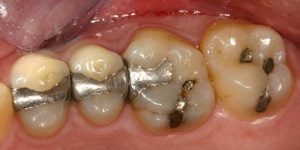
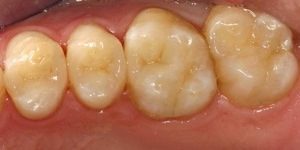
Crowns, commonly known as “caps”, are needed when the majority of the tooth’s structure has been destroyed by severe decay and an inlay/onlay would not adequately cover the area. Crowns are usually required after root canal therapy to strengthen the tooth’s structure and make it more stable. They can also be used to help improve a poor bite, known as malocclusion.
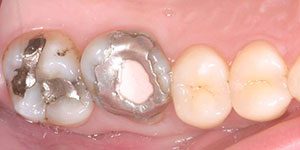 Crowns are larger than inlays/onlays and are placed over the entire tooth. Developed from porcelain and composite material, a crown will enhance the aesthetics of your smile while providing great strength and support. Sometimes crowns necessitate a gold inner structure underneath to provide maximum strength. However, with the advancements in dental technology today, porcelain materials sometimes offer equal strength to that of gold.
Crowns are larger than inlays/onlays and are placed over the entire tooth. Developed from porcelain and composite material, a crown will enhance the aesthetics of your smile while providing great strength and support. Sometimes crowns necessitate a gold inner structure underneath to provide maximum strength. However, with the advancements in dental technology today, porcelain materials sometimes offer equal strength to that of gold.
Dental crowns don’t have to appear dull, chalky, and have a dark line at the gumline. Metal-free ceramics, in combination with modern bonding adhesives, provide strong, durable, and beautiful teeth that rival nature.
Notice the final translucency, gradation of color, and invisible borders. Believe it or not, the margins (borders) are not under the gum line. This allows for superb gum health. I’m sure you have seen those unsightly crowns with the “black-line” effect as seen in the illustration above to the left. This does not happen with modern dentistry!
Metal-free dentistry can rehabilitate the full dentition back to a natural form, dramatically decreasing the risks of tooth fracture, root canal treatments, gum infections, and tooth loss.
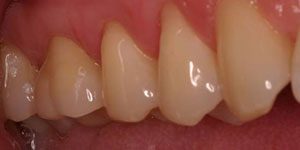
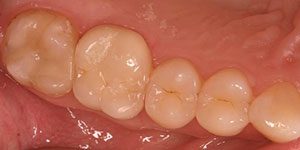
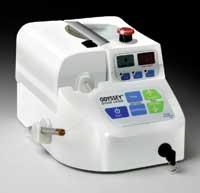 Lasers have forever changed the care we can provide our patients. At Walnut Creek Aesthetic Center, lasers are utilized to recontour gum tissue for a more pleasing appearance and to treat periodontal disease.
Lasers have forever changed the care we can provide our patients. At Walnut Creek Aesthetic Center, lasers are utilized to recontour gum tissue for a more pleasing appearance and to treat periodontal disease.
In the event of gum disease or periodontitis from mild to severe, the laser is the tool and modality of choice. It is a quantum leap in the treatment of a disease that strikes broad and wide throughout the American public. Laser is a gentle, conservative and non-invasive alternative to the old-fashion non-laser cut and suture method. Utilizing a thermal laser that kills up to 99% of the bacteria, which happens to be the cause of periodontal disease, without having to significantly excise or eliminate gum tissue, represents a quantum leap in treatment.
Gum re-contouring
Even with perfect teeth and alignment, a flawed gum line can detract significantly from the beauty of your smile:
- Excess gum tissue can make your teeth look too short
- Receding gums can make your teeth look too long and unhealthy
- An uneven gum line can make your teeth appear to be crooked
- Discolored gums can give an unhealthy look to your smile
We use the Ivoclar Diode Laser in gum re-contouring procedures, correcting all of the problems your gum line is causing. Laser gum re-contouring is safer, less painful, and requires less recover time than gum treatment with a scalpel.
The laser creates less bleeding, reduced chance of infection, is more precise, and produces less swelling.
Periodontal Care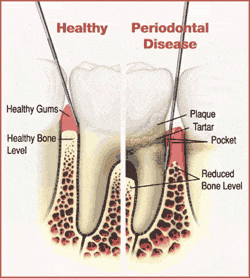
Gum disease is a national epidemic. 90% of the population has some degree, a moderate or advanced infection that destroys the gums and surrounding bone. Untreated gum disease has been proven to dramatically increase heart disease, stroke and respiratory infections. In addition, pregnant mothers with gum disease are at risk for premature and low birth-weight babies.
Never before have so many treatment options been available to treat Periodontal Disease. The use of laser, antimicrobials, and individualized patient education, place our patients in the best position to keep ther teeth for life.
Gum Disease Treatment Is Important for Total Health
Until recently, periodontitis (gum disease) was considered to be only a dental problem with little or no effect on our overall health and well-being. However, recent research shows that this is not true. Periodontal disease can seriously affect the heart and has been shown to contribute to heart disease, as well as other disorders.
Periodontal disease is a serious infection caused by plaque bacteria. Although most of the bacteria are confined to the pockets around the teeth, they can invade the gum tissue and enter the bloodstream, circulating throughout the body.
When you come to our office for a complete examination, we will include a thorough periodontal evaluation. This is a service you should insist on. How much value is there to have us create a beautiful smile, for example, only to lose your teeth prematurely to gum disease? If we want our work to last, we have to give high priority to the health of your gums.
Symptoms of Gum Disease
The problem with gum disease is that most symptoms don’t appear until it’s too late to treat it. Common symptoms are:
- Teeth shifting in position
- Teeth becoming loose
- Gum recession
- Drainage coming from around a tooth
But if you wait until these symptoms appear, you’re at high risk of losing your teeth. That’s why a periodontal examination is so important and why Dr. Rader feels strongly about providing this service to you. Too often, people don’t know they have serious periodontitis until it’s too late.
Bleeding gums are a symptom that some people experience, and this will occur in gingivitis, which is an early stage of gum disease. Your gums aren’t supposed to bleed, and if this occurs, it generally indicates that the teeth aren’t being cleaned properly.
Gingivitis

Gingivitis is simply an inflammation of the gums. It is superficial, and is the first stage of gum disease. Treatment is simple, and involves your basic dental cleaning and good home care including brushing and flossing daily.
Periodontitis

Periodontitis is gum disease that has progressed beyond superficial inflammation of the soft tissues and has begun to involve the bone. In periodontitis, there is destruction of the bony support of the teeth. If it is caught early (early periodontitis) treatment is relatively simple, and usually involves only deep cleaning and possibly more frequent regular maintenance.
In advanced periodontitis, teeth are loose and may have begun to fall out already.
Treatment of gum disease
Traditional treatment for periodontitis involves “scaling and root planing”, which is about as unpleasant as it sounds. A dental hygienist usually performs scaling and root planing with hand instruments to remove calculus. Calculus is a hard deposit on your teeth that occurs both above and below the gumline and is an irritant that leads to infection and bone loss. But scaling and root planing doesn’t remove the biofilm that houses the bacteria, so its effectiveness is limited.


The most advanced technology available in modern dentistry to treat periodontitis is to use micro-ultrasonic instruments and lasers. This combination of technologies actually eliminates the infection rather than managing periodontal disease. A special laser is used to sterilize the periodontal pockets and remove any infected tissue. As the old tissue is removed the body’s natural healing response takes over. The formerly infected tissue reattaches to the bone and the gums return to a healthy, infection-free state. The laser is specifically designed to seek out periodontal infection and does not harm the teeth or other healthy tissue. This is one of the amazing characteristics of lasers. The hygienist calibrates the laser to provide just the right amount of power to treat your gums without causing undue pain or trauma to the tissue. Periodontal laser therapy actually removes the infection and the cost is significantly less than other alternatives that might eventually result in surgery.
Allow us to help you determine the best treatments for your individual needs and desires. One thing we know for certain: you can have a gorgeous smile.
Endodontic care (Root Canal Therapy) is necessary when the nerve tissue in the tooth is irreversibly damaged due to decay, trauma, or tooth fracture. Root canal, though scary sounding, is generally a simple one-two visit procedure that allows a patient to retain a tooth that may have been removed in the past.
Dr. Rader completed thousands of these procedures with extreme success.
Sometimes a root canal is the only way to save an infected tooth and in some cases may also be helpful for cosmetic dentistry.
The whole medical science of the inner tooth is called endodontics. Teeth are actually living organs of your body.
Teeth have several layers. The outside layer of the tooth is composed of a hard layer of Enamel. Enamel is supported by an inner tooth layer called Dentin, and Dentin at its center is a soft tissue known as the Pulp.
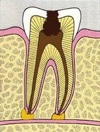
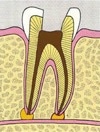
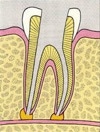
Every tooth has an inner core of soft pulp that holds blood, essential fluids and the tooth’s nerve. The sensations of hot and cold, pressure, and pain are all transmitted to your brain through the nerve inside the pulp.
Although the pulp is important during development of your tooth, it is not necessary for the tooth to remain functional and healthy. The tooth continues to be nourished by the tissues surrounding it even if the pulp is removed.
Endodontic or root canal treatment is necessary when the pulp becomes inflamed or infected. The most common reasons for inflammation or infection are deep cavities, repeated dental procedures like replacing old fillings, cracks or chips. Trauma can also cause inflammation and often shows up as discoloration of the tooth. If pulp inflammation or infection is left untreated, it can cause pain or lead to an abscess and tooth loss.
Once the pulp of a tooth gets infected, there is no real way to cure it without root canal treatment. The most common symptoms of an infected tooth are throbbing pain, sensitivity to chewing hard foods, and sensitivity when drinking hot or cold liquids. Root canal treatment can provide instant relief of this pain.
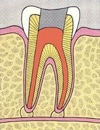
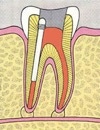
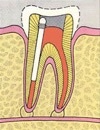
When performing certain cosmetic procedures, endodontics can be effective in achieving optimal cosmetic results. Endodontics allows for immediate straightening and recontouring of crooked teeth in the cosmetic smile zone.
The bonus is instant orthodontics.
If you think you have an infected tooth, it is important to get an examination promptly. Based on what we discover, we will recommend the most conservative treatment that makes things better for you.
Please request your complimentary information packet or contact Dr. Rader to arrange for a complimentary private consultation. Make your request today. If you are experiencing pain, let us know when you fill out the form and we will schedule your visit as soon as possible.

